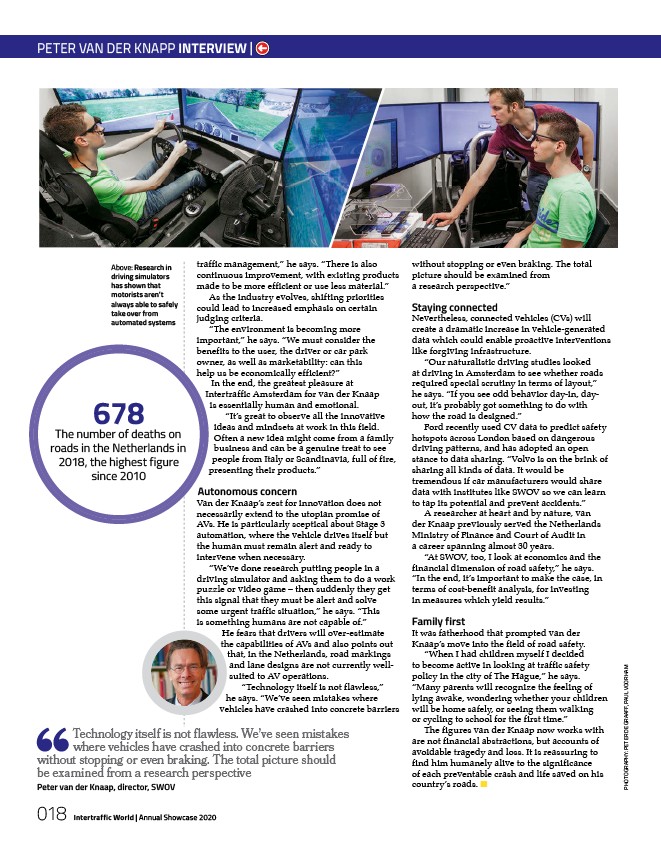
PETER VAN DER KNAPP INTERVIEW |
traffic management,” he says. “There is also
continuous improvement, with existing products
made to be more efficient or use less material.”
As the industry evolves, shifting priorities
could lead to increased emphasis on certain
judging criteria.
“The environment is becoming more
important,” he says. “We must consider the
benefits to the user, the driver or car park
owner, as well as marketability: can this
help us be economically efficient?”
In the end, the greatest pleasure at
Intertraffic Amsterdam for van der Knaap
is essentially human and emotional.
“It’s great to observe all the innovative
ideas and mindsets at work in this field.
Often a new idea might come from a family
business and can be a genuine treat to see
people from Italy or Scandinavia, full of fire,
presenting their products.”
Autonomous concern
Van der Knaap’s zest for innovation does not
necessarily extend to the utopian promise of
AVs. He is particularly sceptical about Stage 3
automation, where the vehicle drives itself but
the human must remain alert and ready to
intervene when necessary.
“We’ve done research putting people in a
driving simulator and asking them to do a work
puzzle or video game – then suddenly they get
this signal that they must be alert and solve
some urgent traffic situation,” he says. “This
is something humans are not capable of.”
678 The number of deaths on
roads in the Netherlands in
2018, the highest figure
since 2010
018 Intertraffic World | Annual Showcase 2020
He fears that drivers will over-estimate
the capabilities of AVs and also points out
that, in the Netherlands, road markings
and lane designs are not currently wellsuited
to AV operations.
“Technology itself is not flawless,”
he says. “We’ve seen mistakes where
vehicles have crashed into concrete barriers
without stopping or even braking. The total
picture should be examined from
a research perspective.”
Staying connected
Nevertheless, connected vehicles (CVs) will
create a dramatic increase in vehicle-generated
data which could enable proactive interventions
like forgiving infrastructure.
“Our naturalistic driving studies looked
at driving in Amsterdam to see whether roads
required special scrutiny in terms of layout,”
he says. “If you see odd behavior day-in, dayout,
it’s probably got something to do with
how the road is designed.”
Ford recently used CV data to predict safety
hotspots across London based on dangerous
driving patterns, and has adopted an open
stance to data sharing. “Volvo is on the brink of
sharing all kinds of data. It would be
tremendous if car manufacturers would share
data with institutes like SWOV so we can learn
to tap its potential and prevent accidents.”
A researcher at heart and by nature, van
der Knaap previously served the Netherlands
Ministry of Finance and Court of Audit in
a career spanning almost 30 years.
“At SWOV, too, I look at economics and the
financial dimension of road safety,” he says.
“In the end, it’s important to make the case, in
terms of cost-benefit analysis, for investing
in measures which yield results.”
Family first
It was fatherhood that prompted van der
Knaap’s move into the field of road safety.
“When I had children myself I decided
to become active in looking at traffic safety
policy in the city of The Hague,” he says.
“Many parents will recognize the feeling of
lying awake, wondering whether your children
will be home safely, or seeing them walking
or cycling to school for the first time.”
The figures van der Knaap now works with
are not financial abstractions, but accounts of
avoidable tragedy and loss. It is reassuring to
find him humanely alive to the significance
of each preventable crash and life saved on his
country’s roads. ■
Above: Research in
driving simulators
has shown that
motorists aren’t
always able to safely
take over from
automated systems
Technology itself is not flawless. We’ve seen mistakes
where vehicles have crashed into concrete barriers
without stopping or even braking. The total picture should
be examined from a research perspective
Peter van der Knaap, director, SWOV
PHOTOGRAPHY: PETER DE GRAAFF, PAUL VOORHAM